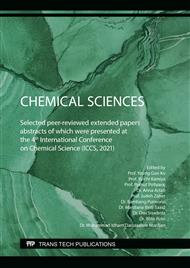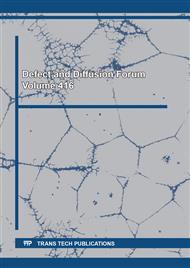[1]
Y.N. Sudhakar, M. Selvakumar, D.K. Bhat, Biopolymer electrolytes for fuel cell applications, in: Biopolymer Electrolytes, Elsevier, Amsterdam, Netherlands, 2018, p.151–166.
DOI: 10.1016/b978-0-12-813447-4.00005-4
Google Scholar
[2]
B. Smitha, S. Sridhar, A.A. Khan, Chitosan–poly(vinyl pyrrolidone) blends as membranes for direct methanol fuel cell applications, J. Power Sources 159 (2006) 846–854.
DOI: 10.1016/j.jpowsour.2005.12.032
Google Scholar
[3]
S.D. Pasini Cabello, S. Mollá, N.A. Ochoa, J. Marchese, E. Giménez, V. Compañ, New bio-polymeric membranes composed of alginate-carrageenan to be applied as polymer electrolyte membranes for DMFC, J. Power Sources 265 (2014) 345–355.
DOI: 10.1016/j.jpowsour.2014.04.093
Google Scholar
[4]
M. Purwanto, L. Atmaja, M.A. Mohamed, M.T. Salleh, J. Jaafar, A.F. Ismail, M. Santoso, N. Widiastuti, Biopolymer-based electrolyte membranes from chitosan incorporated with montmorillonite-crosslinked GPTMS for direct methanol fuel cells, RSC Adv. 6 (2016) 2314–2322.
DOI: 10.1039/c5ra22420a
Google Scholar
[5]
B. Smitha, S. Sridhar, A.A. Khan, Chitosan–sodium alginate polyion complexes as fuel cell membranes, Eur. Polym. J. 41 (2005) 1859–1866.
DOI: 10.1016/j.eurpolymj.2005.02.018
Google Scholar
[6]
M. Shahbazi, G. Rajabzadeh, R. Ettelaie, A. Rafe, Kinetic study of κ-carrageenan degradation and its impact on mechanical and structural properties of chitosan/κ-carrageenan film, Carbohydr. Polym. 142 (2016) 167–176.
DOI: 10.1016/j.carbpol.2016.01.037
Google Scholar
[7]
F. Bilo, S. Pandini, L. Sartore, L.E. Depero, G. Gargiulo, A. Bonassi, S. Federici, E. Bontempi, Sustainable bioplastic obtained from rice straw, J. Cleaner Prod. 200 (2018) 357–368.
DOI: 10.1016/j.jclepro.2018.07.252
Google Scholar
[8]
C. Yang, Fabrication and characterization of poly(vinyl alcohol)/montmorillonite/poly (styrene sulfonic acid) proton-conducting composite membranes for direct methanol fuel cells, Int. J. Hydrogen Energy 36 (2011) 4419–4431.
DOI: 10.1016/j.ijhydene.2011.01.011
Google Scholar
[9]
D. Permana, M. Purwanto, L.O.A.N. Ramadhan, L. Atmaja, Synthesis and characterization of chitosan/phosphotungstic acid-montmorillonite modified by silane for DMFC membrane, Indones. J. Chem. 15 (2015) 218–225.
DOI: 10.22146/ijc.21188
Google Scholar
[10]
R. Dwimayasanti, B. Kumayanjati, Karakterisasi edible film dari karagenan dan kitosan dengan metode layer by layer, JPBKP 14 (2019) 141–150.
DOI: 10.15578/jpbkp.v14i2.603
Google Scholar
[11]
S.Y. Park, B.I. Lee, S.T. Jung, H.J. Park, Biopolymer composite films based on κ-carrageenan and chitosan, Mater. Res. Bull. 36 (2001) 511–519.
DOI: 10.1016/s0025-5408(01)00545-1
Google Scholar
[12]
H.C. Yu, H. Zhang, K. Ren, Z. Ying, F. Zhu, J. Qian, J. Ji, Z.L. Wu, Q. Zheng, Ultrathin κ-carrageenan/chitosan hydrogel films with high toughness and antiadhesion, ACS Appl. Mater. Interfaces 10 (2018) 9002–9009.
DOI: 10.1021/acsami.7b18343
Google Scholar
[13]
M.S.M. Eldin, A.E. Hashem, T.M. Tamer, A.M. Omer, M.E. Yossuf, M.M. Saber, Development of cross-linked chitosan/alginate polyelectrolyte proton exchanger membranes for fuel cell applications, Int. J. Electrochem. Sci. 12 (2017) 3840–3858.
DOI: 10.20964/2017.05.45
Google Scholar
[14]
Y.C. Wong, Y.W. Wong, K. Ramya, M. Khalid, K.S. Loh, W.R.W. Daud, K.L. Lim, R. Walvekar, A.A.H. Kadhum, Additives in proton exchange membranes for low and high-temperature fuel cell applications: A review, Int. J. Hydrogen Energy 44 (2019) 6116–6135.
DOI: 10.1016/j.ijhydene.2019.01.084
Google Scholar
[15]
S. Mohanapriya, V. Raj, Cesium-substituted mesoporous phosphotungstic acid embedded chitosan hybrid polymer membrane for direct methanol fuel cells, Ionics 24 (2018) 2729–2743.
DOI: 10.1007/s11581-017-2406-1
Google Scholar



